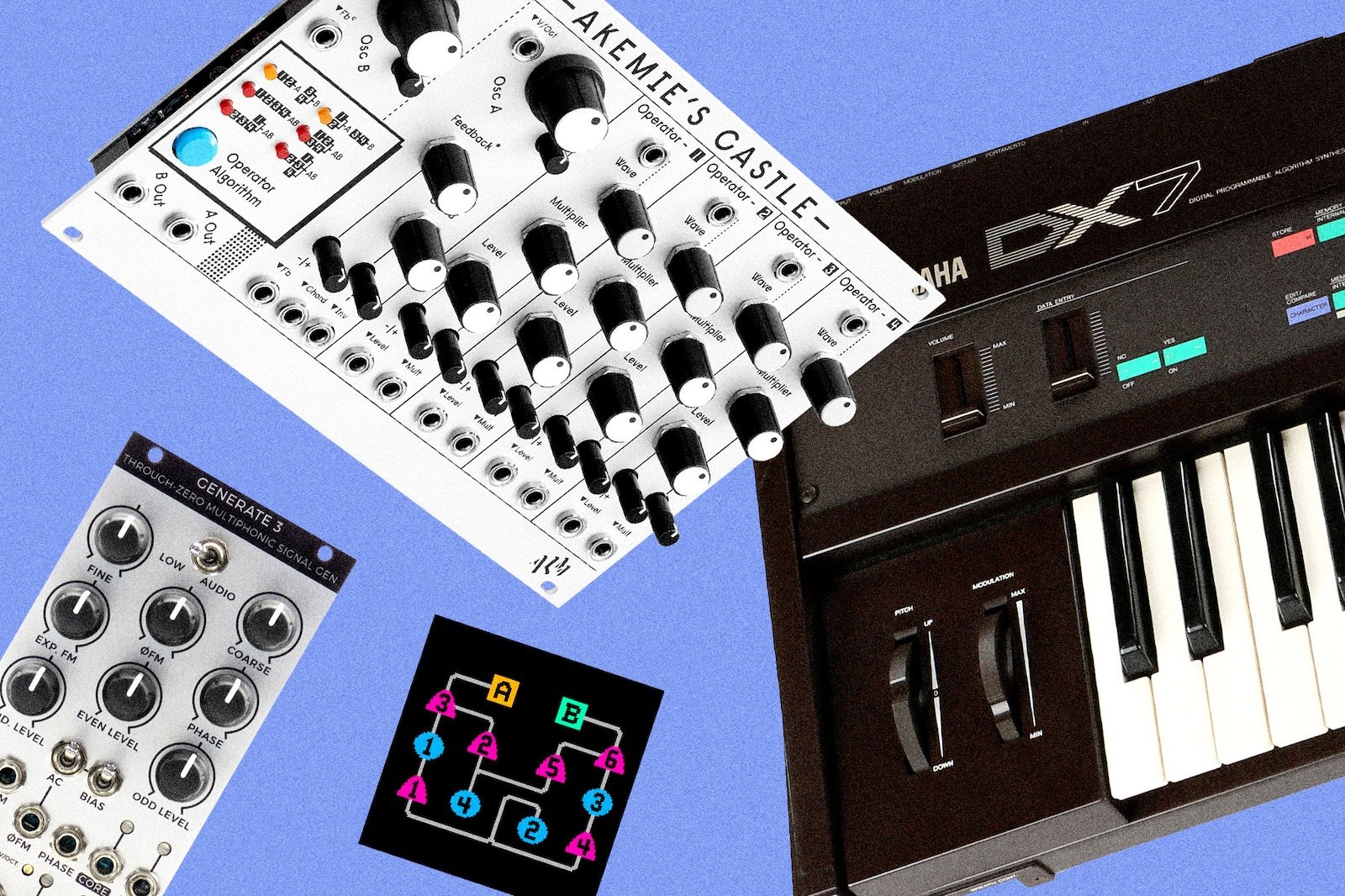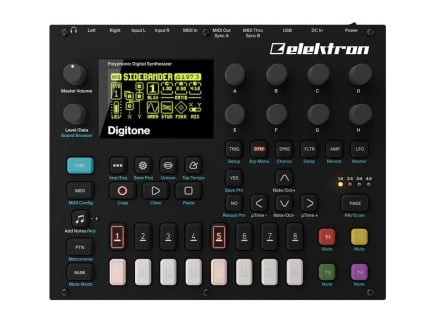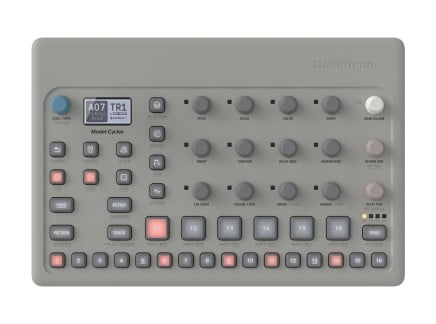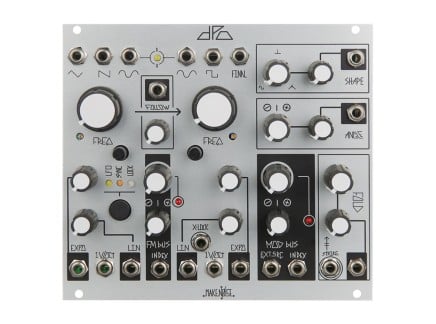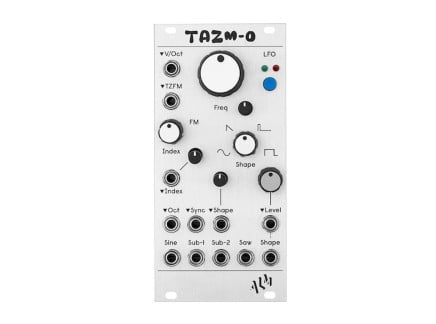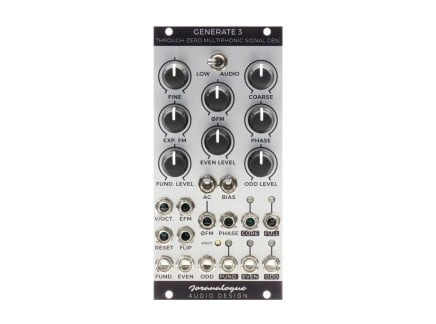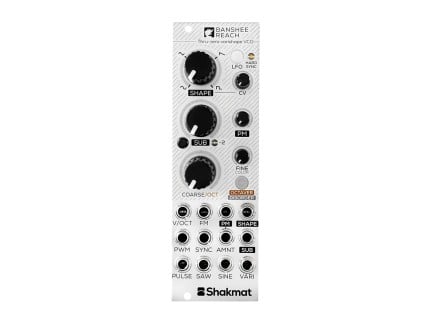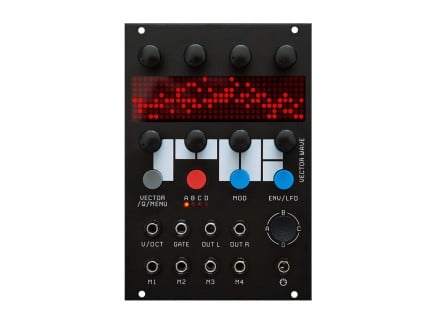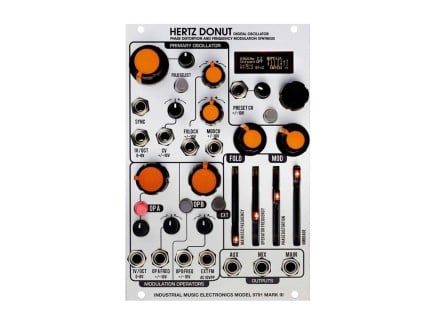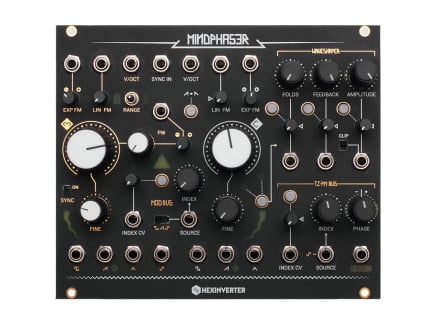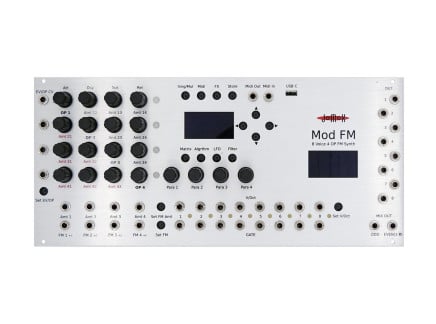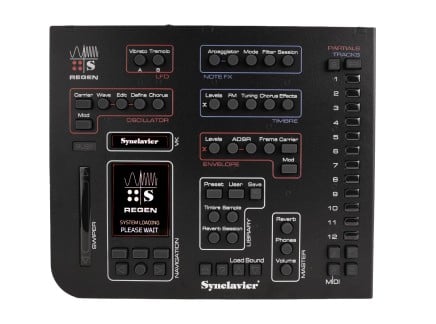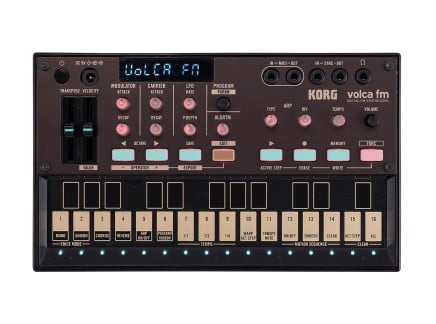It would be an understatement to say that it is extremely rare for new forms of synthesis to be discovered—but in the late 1960s, a composer named John Chowning did just that. Working at the intersection of music and computer science at Stanford University, Chowning's sheer curiosity and experimental spirit uncovered what would become known as Frequency Modulation (or FM) synthesis. Now, this is arguably one of the most significant conceptual frameworks for synthesizing audio altogether.
Fundamentally, what Chowning discovered was that modulating the frequency of one waveform (a "carrier") with another waveform (a "modulator") at high frequencies created sounds unlike those produced by other forms of synthesis. His specific implementation of this technique was able to generate complex, evolving tones and timbres while maintaining independent control of pitch—an amazing feat for the time. Interestingly, it also excelled at creating relatively realistic instrument sounds: strings, bells, kalimbas and horns, to name a few.
Chowning's 1972 composition Turenas, as well as his 1973 paper, “The Synthesis of Complex Audio Spectra by Means of Frequency Modulation”, introduced the concept of FM synthesis to the greater world. The discovery made immediate waves (no pun intended) across the academic and experimental electronic music circles of the time.
[Ed.: for more on the methodology and early history of FM Synthesis, be sure to check out our article Synthesis Methods Explained: What is FM Synthesis?]
FM's Rapid Proliferation
A decade later, in 1983, Chowning's initial discovery found its way out of the world of academia and reached the masses. Yamaha, who had secured rights to produce electronic music hardware based on the FM patent, introduced the FM-powered DX7 synthesizer. Its broad sonic palette and relatively “affordable” price of $1995 (about $6000 in today’s dollars) helped make it one of the best-selling synthesizers of its era, moving more than 200,000 units worldwide.
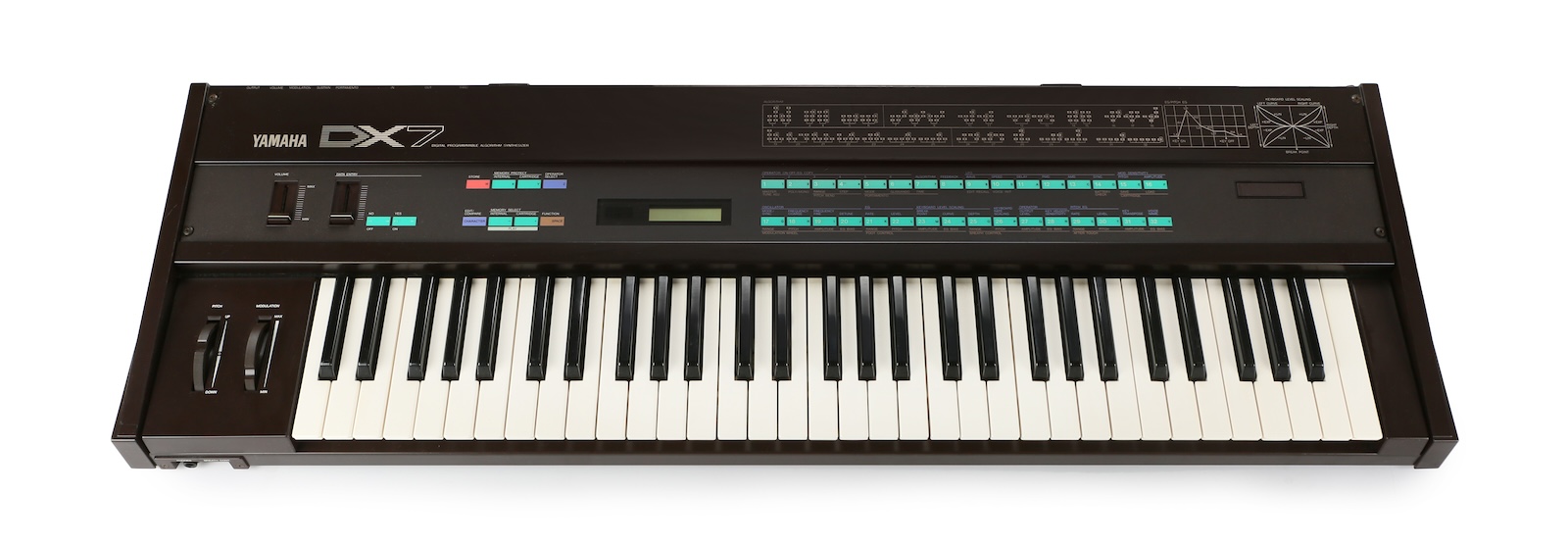
[Above: an original Yamaha DX7; image via Perfect Circuit's archives.]
The DX7 would also become one of the most culturally influential synths of its generation. It can be heard on countless pop records throughout the 1980s: Harold Faltermeyer’s "Axel F," featured in the movie Beverly Hills Cop; Whitney Houston’s "Greatest Love of All"; A-ha’s "Take on Me"; and Giorgio Moroder’s "Take My Breath Away," written with collaborator Arthur Barrow and featured in the '80s blockbuster movie Top Gun. Queen guitarist Brian May was a fan of the DX7, and used it for the intro of "Who Wants to Live Forever." Kraftwerk, Underworld, Orbital, Talking Heads, and Jean-Michel Jarre can be counted among its many enthusiasts.
But while the DX7 produced remarkable sounds, the sheer complexity of FM synthesis, combined with the synth’s rather limited set of menus and controls, meant that few were actually able to successfully program their own patches on the device. As such, for most producers it became something of a “preset machine.” (Fun fact: The original sound designers had planned on including 32 presets, but were told at the last minute by their bosses at Yamaha that the number would in fact be 128). What makes it so complex to use? Well, while the DX7 offered a wide (and even inspiring) range of modulation possibilities, actually comprehending and navigating its enormous number of interrelated parameters was unwieldy, to say the least. The DX7 lacked the real time, hands-on controls that analog synthesizers offered, with a screen that displayed numeric values and often confusing abbreviations for parameters. And of course, its concepts were entirely new: while commercial analog synthesizers had been around for fifteen years and were generally well-understood, the DX7's sound generation techniques presented a new conceptual framework for creating interesting sounds. That combined with its somewhat impenetrable user interface meant that very few musicians programmed their own sounds, and instead just stuck with the presets. As a side effect, FM synthesis in general earned something of a bad rap for decades to follow.
Notably, the artist and producer Brian Eno was one of the few exceptions to this rule, and leaned heavily on the DX7 for both his own musical output, as well as that of various bands he produced (such as U2). Eno was rumored to own seven DX7s at one point, and was such a fan that he even shared some of the patches he programmed with Keyboard Magazine in 1987.

[Above: a period advertisement for Yamaha's DX series of FM-powered synthesizers.]
Yamaha followed the DX7 with an entire family of synthesizers, including other synths like the DX1, DX21, DX27 and DX100. However, each of these struggled with the same sorts of UI/UX issues: namely, how to make interfacing with FM synthesis as hands-on and as creatively rewarding as working with traditional subtractive synthesis. [Ed.: see our dedicated article about the Yamaha DX series for more detailed information.]
Because of Yamaha's right to the FM patent, they essentially monopolized the market for FM synths until the patent's expiration in the mid-1990s. (In fact, the FM synthesis patent became "the second most lucrative licensing agreement in Stanford's history” as of 1994, bringing the university some $20 million before it expired.) The patent's expiration opened the floodgates, and a number of hardware and software FM synthesizers would emerge in the 1990s and 2000s.
Over time, musicians have become more familiar with the techniques of FM synthesis. Simultaneously, other designers having the right to use FM technology has ultimately led to a number of new approaches to user interface design. As such, we modern music makers and sound designers live within something of an FM synthesis renaissance—where it's easier to use FM than ever before. Let's take a look at a number of modern-day software and hardware instruments, identifying their specific and interesting spins on creating a useful FM user experience.
Modern Software Approaches to FM Synthesis
Let's take a look at a quick sampling of common software tools for FM synthesis. Some of these are old standbys, and some are underrated new offerings. In each case, these programs present a novel approach to handling FM's complexities—breaking past the notorious usability barrier presented by the Yamaha DX series.
Ableton Operator
Introduced as part of Ableton Live 4 back in 2004 and designed primarily by prolific artist and technologist Robert Henke, Operator has been a mainstay for countless Live producers. Operator presents a visual representation of the FM algorithms as a matrix, allowing users to easily visualize and configure modulation routing between operators.
[Above: a 2009 demo of Ableton's Operator.]
Macro controls, meanwhile, allow users to map multiple parameters to a single control, simplifying the process of sound design by providing a way to manipulate several parameters simultaneously to create complex, evolving sounds with a single knob or slider. Operator also offers a range of oscillator algorithms beyond the pure sine waves of traditional FM synthesis, including pulse, sawtooth, and triangle waveforms for use as carrier and modulator signals. Operator also includes a built-in filter and modulation sources, with various filter types, envelopes, and LFOs that can be applied to individual operators or the summed output signal, allowing for more dynamic timbral variation.
Finally, as a native Live device, Operator fits into a production workflow like no FM synthesizer before it (or, arguably, after it). It can be automated, modulated, and MIDI mapped inside Live's session and arrangement views, providing a ripe environment for composition and performance with FM sounds. It remains an essential piece of the Live toolkit, providing deep and powerful sound design and flexibility from a device that requires minimal CPU usage.
Native Instruments FM8
Introduced a few years later, Native Instruments’ FM8 also helped bring FM synthesis wide adoption in the software realm. Like Ableton’s Operator, FM8 provides a visual matrix for easy routing between carrier and modulator waveforms. It also introduced the concept of morphing between different FM configurations, whereby users could smoothly transition between different ratios, waveforms and routings, creating ever-more dynamic and evolving sounds. It even includes formant filters, which allow users to shape the harmonic content and create vowel-like sounds with FM (perhaps borrowing inspiration from the powerful-yet-impenetrable Yamaha FS1R rack module).
FM8’s Easy Edit page was also something of a revelation at the time of its introduction, presenting a curated set of parameters relevant to whatever sound was selected, making for easier adjustments at a glance. The Transient Envelope, likewise, is an envelope specifically designed to shape the attack phase of FM sounds.
Finally, FM8 introduced the concept of primary and secondary operators, where operators could modulate each other's parameters to create more intricate, dynamic relationships. While its interface feels a bit long in the tooth these days, FM8 is still capable of some fantastic sound design, and will run butter-smooth on even the meekest computer you can find at your local thrift shop.
ModOsc Designs ID700
While there are a number of other software FM synthesizers out there, the ModOsc Designs ID700 is one of the most notable and peculiar; and it's a favorite among the Signal writing staff. It’s based on Don Buchla’s 700—a brilliant and vanishingly rare instrument from the late 1980s. The 700 offered 12 voices with four oscillators per voice, utilizing FM, waveshaping, a unique approach to additive synthesis, and extensive opportunities for internal modulation and customized user interaction. It went far beyond the traditional territory of FM synthesis, but regrettably, only a dozen or so 700s were ever produced.
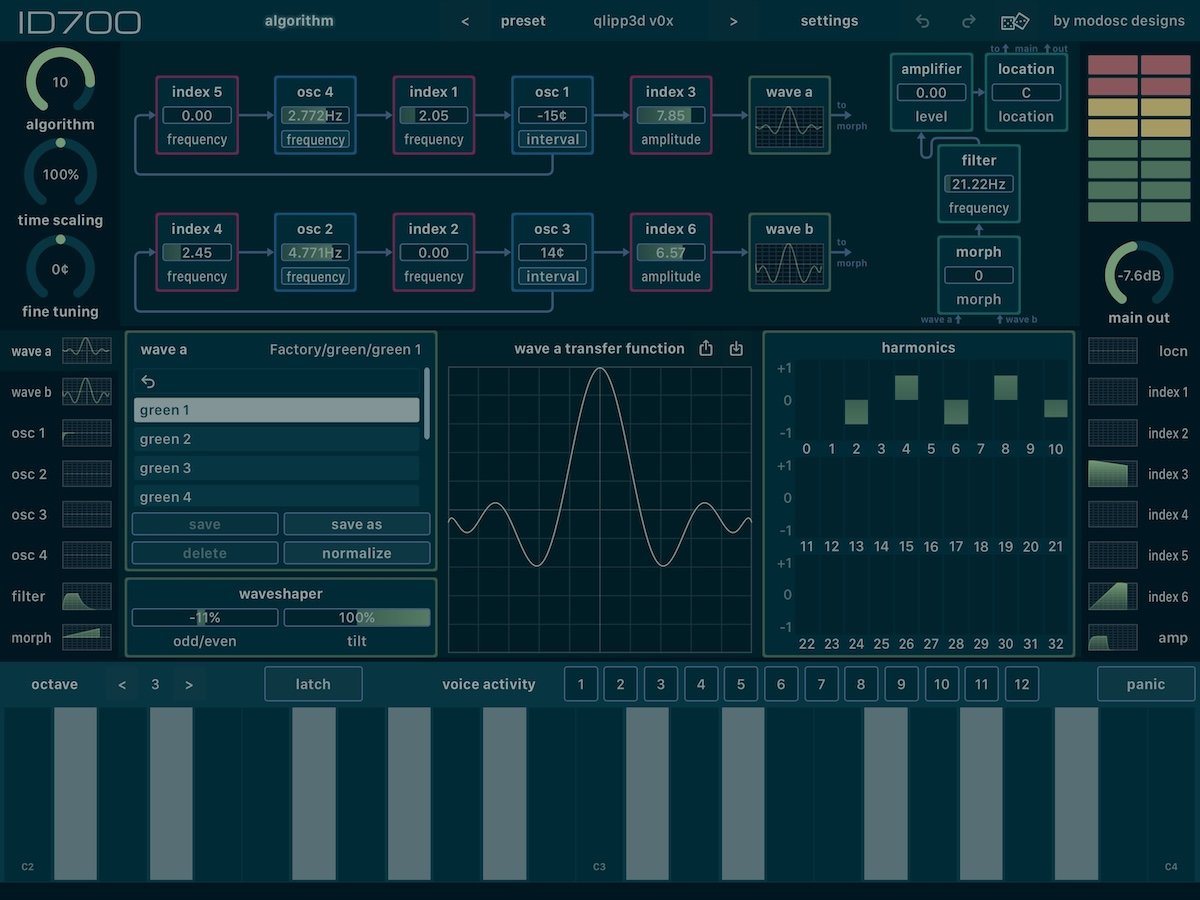
In 2021, Jonathan Schatz, a software designer and musician who worked with Buchla on the later 200e series, released his loving take on the 700 for Mac and iOS: ID700. Rather than recreating the 700 experience in its entirety, it instead focuses only on reimagining the 700's sound engine—leaving the 700's score editor, multi-timbral behavior, and sequencing capabilities behind.
What you get, though, is still a staggeringly powerful instrument: a 12-voice, 4-operator FM synthesizer with complex, multi-breakpoint envelope generators for each important parameter. It includes the same peculiar waveshaping techniques found in the original 700, and many of the extensive options for expressive user control. It's not an "exact clone" of the 700, of course, but it takes all of the synthesis concepts at work in the original and presents them in a form that makes a lot of sense for modern musicians. It's easy to visualize what it's doing at any given moment; it's easy to edit; and it will lead you to plenty of sounds that you had absolutely never imagined.
Modern Standalone Hardware Approaches to FM Synthesis
The world of hardware design has also evolved—and along with it, adventurous designers are developing their own takes on FM Synthesis. Let's look at a few of our favorites.
Elektron Digitone and Model:Cycles
In the modern era, Elektron has been one of the great champions of hardware-based FM synthesizers. Its FM flagship, the Digitone, introduced in 2018, provides multiple operators with adjustable algorithms and a wide range of modulation possibilities, giving users extensive control over the timbre and texture achievable through FM. Its eight-voice, four-operator sound engine allows users to create rich harmonic structures with FM, including a dedicated overdrive circuit that could be applied to each voice individually — adding warmth and saturation to the typically more clean and clinical FM sound, enhancing it with a more analog-like quality.
Additionally, the Digitone brought Elektron’s top-notch hardware workflow to the FM equation for the first time. With a bit of programming, Elektron's inimitable sequencer can create remarkably dynamic patterns, complete with parameter locks that allow users to modulate FM parameters in a precise, hands-on manner for expressive FM sequences. While software FM synths can obviously be sequenced, automated and looped in endless ways, being able to sculpt FM parameters over time directly on the hardware in this way still feels immediate and exciting.
While not quite as deep or feature-packed as its older sibling the Digitone, Elektron’s Model:Cycles provides a great, affordable entry point for a hardware-based FM groovebox. Featuring six dedicated FM synth engines (known as “machines”) that can be used on any of the six tracks, using the Cycles is immediately satisfying.
Each "machine" is curated with its own set of operators and modulation options, allowing for a variety of FM sounds ranging from classic bell-like tones to complex textures. Each machine is named for the types of sounds it was tailored to create: Kick, Snare, Metal, Perc, Tone, and Chord. This naming scheme takes the guesswork out of the more complex aspects of FM synthesis; you no longer need to know specifically what algorithm to reach for, or which envelopes are most important for a particular type of sound…instead, you can get straight to making music with its clever and quite effective per-machine parameterization.
Additionally, the Cycles leverages the same powerful sequencer parameter locking as the Digitone, and a host of performance features—namely the ability to control the same parameter across all six tracks simultaneously—which can create some gloriously messy and profound FM results.
Korg Opsix
Korg’s Opsix was not long for this world: it was released in late 2020, and discontinued earlier this year (rumor has it that this short retail lifespan was due to insurmountable pandemic-driven parts shortages). We regard this as a shame, because the Opsix presented a truly exciting and new approach to FM. Luckily, the synth can still be found on the used market, and the Opsix lives on in the form of a AU/VST3/AAX/ST3 software plugin, bringing a number of cool ideas to FM the synthesis canon.
Officially dubbed an “Altered FM Synthesizer”, the Opsix introduced Variable Phase Modulation, a modification of traditional FM synthesis. VPM allows for more precise and complex control over relationship between the modulator and carrier signals in FM synthesis, resulting in more harmonically rich and expressive sounds.
Like other synths included here, the Opsix also offers flexible operator routing, allowing users to freely route the modulation signals between operators, as well as a variety of high-quality filters and effects that can be applied either to individual operators (that's a big deal) or to the overall sound output. In fact, operators can do much more than just produce a signal: specialized operator modes allow for wavefolding, filter FM, and much more. As such, the Opsix reaches into territory that we've otherwise never seen (or heard!).
Thanks to its large color display and bounty of knobs and sliders to control its parameters, the hardware Opsix brought an impressive level of physical tactility to the FM workflow as well, and its extensive modulation capabilities (read: multiple envelope generators, LFOs and other modulation sources) are freely assignable as well. The software plugin version includes all the features of its hardware sibling, and is available for Mac, PC and iPad. For those who own both the hardware and software versions, Opsix patches are also interchangeable across all platforms.
Kodamo EssenceFM
The only rackmountable synthesizer included in this roundup, the Kodamo EssenceFM looks at first glance like it jumped right out of a 1990s music studio. Investigate a little closer, however, and it becomes clear that this is a decidedly modern FM powerhouse.
Running on a beefy ARM processor, EssenceFM sports a fairly insane 300 voice polyphony, eight assignable outputs, built-in effects, and a huge seven-inch multitouch display. There’s support for micro tuning, user-configured algorithms, user-definable operator wave shapes, a host of advanced splitting and layering options, a round robin mode for cycling between different sounds (great for drum design), not to mention MPE support. It's quite possibly the most comprehensive hardware FM synthesizer ever developed.
Its hybrid combination hardware/touchscreen interface is truly one-of-a-kind in today’s FM synthesizer landscape, and for programming complex, evolving FM patches—not to mention morphing between them with the multitouch display—it’s as deep as anything else out there.
Modern Approaches to FM in Eurorack Modular Synthesizers
Of course, Eurorack is another important arena, offering several other unique approaches to FM synthesis. Let's take a quick look at some highlights.
Make Noise DPO
One of the earliest implementations of analog frequency modulation in musical instruments predated Yamaha's use of Chowning's specific methods: Don Buchla's oscillator designs have always allow for analog frequency modulation, since their beginnings in the Buchla 100 series. Eventually—long after their initial development—instruments like the Buchla Music Easel and 200 Series led to the popularization of the "complex oscillator" concept: a special type of dual oscillator module focused on waveshaping and internal inter-oscillator modulation, almost always including analog FM. Of course, the effects of analog FM are quite different from the sound of Yamaha-esque phase modulation techniques, but today, analog complex oscillators are one of the key tools for exploring this particular flavor of FM.
One of the first complex oscillators in the Eurorack format was the DPO (Dual Prismatic Oscillator) by Make Noise, first introduced in 2013. Given that Buchla's original instruments were produced in small quantities, the DPO was perhaps the first easily-accessible/purchaseable "complex oscillator" altogether, introducing some Buchla's ideas to the public for the first time.
To this day, the DPO is one of the most popular analog oscillators in Eurorack format altogether. It provides both linear and exponential FM, including the possibility for complex cross-modulation. If you're looking for an oscillator that makes the most of pre-Chowning analog FM wildness, then DPO is an easy recommendation.
ALM/Busy Circuits Akemie's Castle + Akemie's Taiko
Akemie's Castle is another long-standing favorite FM-centric Eurorack module, this time bringing Yamaha-style FM directly to your modular synthesizer. Using actual new old stock Yamaha FM integrated circuits, Akemie's Castle provides a four-operator architecture with hands-on controls for each individual operator's shape, level, and pitch multiplier value. Offering two oscillator structures and a selection of algorithms that accommodate duophonic use or highly complex four-operator techniques, it's capable of a huge range of sounds.
The end result is one of the most intuitive and hands-on implementations of classic FM Synthesis we've ever seen. Even years after its initial introduction, Akemie's Castle still holds its own.
A different take on similar concepts, Akemie's Taiko is a digital percussion voice, inspired by Japanese taiko drums and offering a range of complex, flexible drum sounds. Once again utilizing NOS Yamaha FM ICs, Akemie's Taiko occupies a similar sound world as its older sibling, the Castle—but its parameterization is tailored specifically toward the creation of percussive sounds. It offers four operators, six FM algorithms, eight wave shapes, and an extensive assortment of CV inputs…including a CV input for algorithm selection. If you want quick and easy access to FM percussion, this module is incredible.
A Quick Word on Through-Zero Frequency Modulation
We'll take a quick aside here to briefly address a hot topic in the world of analog FM: Though-Zero Linear Frequency Modulation or TZFM, a technique directly related to Chowning's phase modulation method. What's so special about TZFM, and why is everyone talking about it?
One of the tricky things about FM synthesis has always been maintaining pitch accuracy. In traditional linear FM, the modulation signal directly affects the carrier frequency; this results in changes above or below the carrier's base frequency. In some cases, at extreme FM depths when the resulting theoretical frequency goes below zero, this can cause the sense of pitch to gradually drift upward—fine for some applications, but not for situations that rely on pitch, melody, or harmony as important musical parameters.
As with phase modulation, TZFM allows an oscillator's phase to reverse when the oscillator frequency dips "below zero Hz" at extreme modulation depths. TZFM thereby keeps the perceived sound relatively in tune, regardless of the applied modulation depth; this creates a broader range of sonic possibilities, and avoids the pitch drift commonly associated with analog exponential and extreme linear frequency modulation. The outcome can be more consistent, balanced and musically pleasing.
While by no means exclusive to the modular format, TZFM has found its modern home in a number of powerful Eurorack modules (of both the analog and digital varieties) in recent years, and the technique is sure to find new and exciting implementations there in the years to come. Let's look at some currently-available TZFM-capable Eurorack modules.
Intellijel Designs Rubicon 2
Intellijel's Rubicon was one of the first Eurorack oscillators that brought public attention to the TZFM technique. It's a remarkably fully-featured analog oscillator even without bringing TZFM into the equation, with distinct waveshape outputs aplenty, multiple types of FM and sync, and much more. It quickly gained traction and respect because of the grace with which it handled extreme frequency modulation—turning a technique that typically produced clangorous, inharmonic results into something with newfound musical applications.
It remains a top recommendation for analog TZFM oscillators to this day; if you need a remarkably fully-featured oscillator designed for TZFM and exploration of different types of waveshapes and modulation, it's a solid choice.
ALM/Busy Circuits TAZM-O
Also from ALM, TAZM-O is one of the latest TZFM-enabled Eurorack oscillators on the scene, enabled (like many) by the Sound Semiconductor SSI2130 VCO chip.
TAZM-O is an analog triangle core oscillator featuring through-zero FM, with continuous morphing wave/pulse width shape control, and TZFM index control. The latter includes both direct as well as voltage control over this modulation index, which allows for classic dynamic-depth FM tricks without the need for an additional VCA.
TAZM-O is a great choice if you want a compact oscillator with continuously variable waveshape modulation, TZFM, and all the other basic tricks you'd expect from an analog oscillator.
Joranalogue Generate 3
[Above: a stellar demo of Joranalogue's Generate 3 by the inimitable DivKid.]
At the core of Joranalogue's Generate 3 is a precise triangle-core VCO. The triangle wave is passed through a though-zero phase modulator, offering an extensive phase shift range of 900 degrees, providing an intriguing alternative to traditional FM, producing deep FM-like tones without altering the oscillation frequency.
Generate 3 is capable of much more, as well; and it provides a powerful platform for anyone looking to explore the boundaries of analog oscillator techniques. You'll get several flavors of FM, sync, and independent outputs for odd and even harmonics, each with independent level adjustments and CV inputs. If you want a TZFM-capable oscillator that breaks out of other conventional oscillator tropes, you'll find it to be a unique and inspiring offering.
Shakmat Banshee Reach
One of the latest developments on the TZFM analog oscillator front is Shaktmat's Banshee Reach. It gives you through-zero frequency/phase modulation, with an on-board VCA for dynamic modulation of the FM depth.
To further steady its pitch tracking capabilities, the module features digital control for frequency locking and octave transposition—ideal for ensuring you don't accidentally "bump" the oscillator out of tune. Offering fixed and variable waveshape outputs (with waveshape modulation), PWM, sync, and a suboscillator output, it packs a surprising amount of functionality into a small space: only 8hp, in fact. It's a great choice if you want to explore TZFM and other traditional oscillator tricks without taking up much room—and for some, the tuning lock feature will prove to be indispensable.
It's Not Just a Phase
FM Synthesis has become one of the most prevalent and popular means by which musicians create and shape electronic sound. Its earliest hardware implementations left something to be desired in terms of programmability—but, with the introduction of improved user interfaces and the spread of general knowledge about using FM, it has become ever-more popular and useful to modern producers.
Of course, there are countless other devices that made fascinating use of FM—the Humble Audio Quad Operator Eurorack module, the Yamaha Montage, the Korg Volca FM, and many, many more. And, no doubt we'll see plenty more inspiring appraoaches borne from the FM method: so, here's looking to the future.

